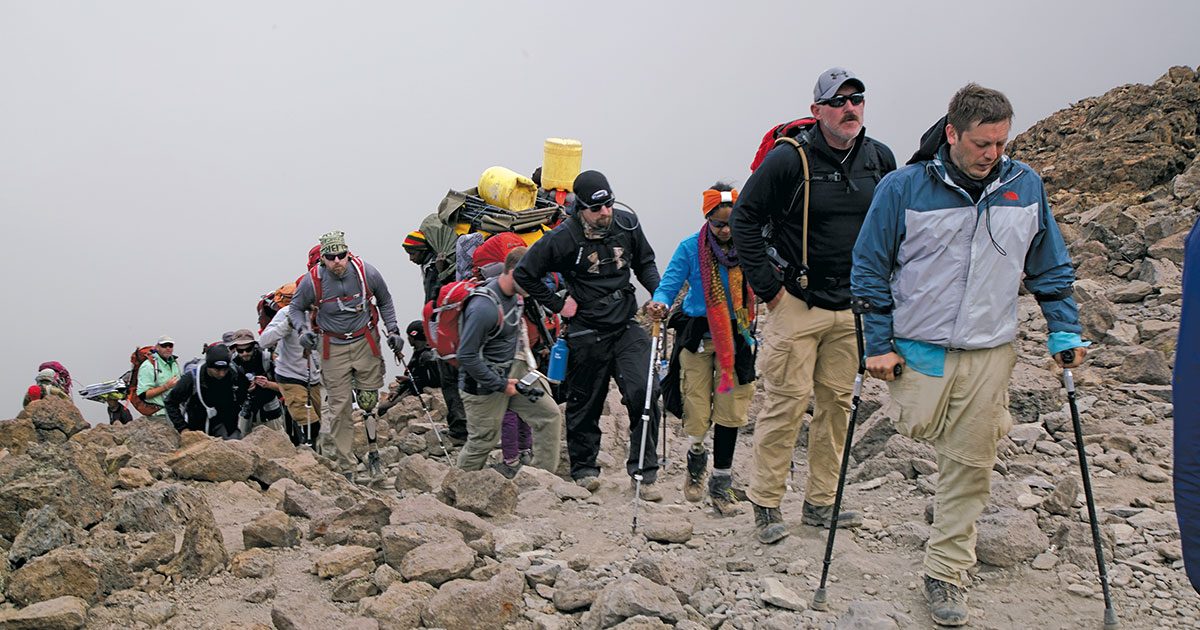Volume 26, Issue 4 July/August 2016 | Download PDF
by Tony Phillips | photos provided by San Antonio Amputee Foundation
Mount Kilimanjaro rises more than 19,000 feet above Tanzania. From base to summit, it is the fourth-tallest mountain in the world, the highest point in all of Africa. Shrouded in mist and history, Kilimanjaro’s grey, ice-covered peak pierces the African clouds where dauntless climbers stand in triumph above an ancient land. More begin the climb than finish it. Some turn back before reaching the summit and a few die, perhaps a half-dozen each year, victims of falls, hypothermia and such scourges as acute mountain sickness and high-altitude cerebral edema. The summit of Kilimanjaro is an inhospitable realm for even the fleet and the fit, not a place where you would expect to find nine amputees.
The Cloud Walkers are a team brought together by San Antonio Amputee Foundation Executive Director Mona Patel. They embarked December 2015 on a trek to the top of Kilimanjaro, an eight-day quest that challenged each climber’s body and mind. Patel was one of nine amputees who made the climb. A mother of two in her 40s, she lost her right leg below the knee to a drunk driver 25 years ago. The Cloud Walkers’ eight other amputees were Kevin Robinson, Patrick Hayes and Johnny Martinez, all below-knee, George Osgood, above-knee, Scott Wilson, below-elbow, Ian Warshak, bilateral below-knee and all fingers, Cory Torres, hip disarticulation, and Justin Pfaff, team prosthetist, missing all fingers on his right hand and all toes on both feet. The three other team members were Karwin McCain, team physician, Greg Lego, team physical therapist, and Rick Smith, team medic. The team was joined by a three-man film crew to form a most unlikely fifteensome assaulting Kilimanjaro on New Year’s Eve.
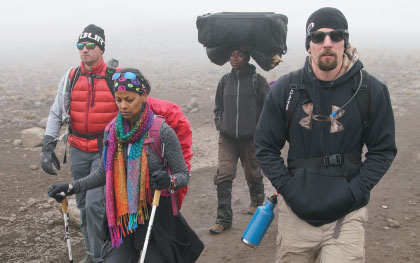
Scott, Mona and Justin, followed by one of their porters.
Patel is effusive in her account of the climb, noting each climber’s unique challenges and the inspiration they gave her. She talks freely and at length about the months of organization, training, logistical planning, fundraising and sponsor recruitment leading up to the event itself. She set the goal for herself to climb Kilimanjaro after completing a 13-hour Navy SEALFIT challenge. Her personal goal grew into a vision that included a team of challenged climbers, and one wonders why. Why lead a team of physically challenged climbers on an adventure that has claimed the lives of many an able-bodied mountaineer?
Why spend hour upon hour, day after ceaseless day raising funds, sourcing equipment, placating sponsors, dealing with travel plans and negotiating rates with porters half a globe away?
“I thought, ‘Why not?’” says Patel. “Why not bring together people who could use the trek to continue healing and growing emotionally, and why not inspire others along the way?”
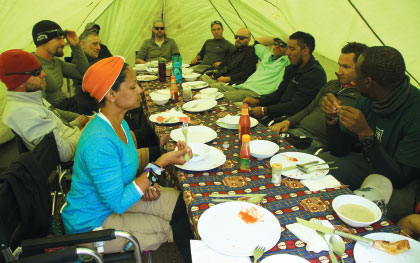
Unwinding in the meal tent.
The plan to climb Kilimanjaro and the compelling stories of the Cloud Walkers themselves drew attention from the outset, with a team of filmmakers documenting the project from its inception, through a year of training and culminating at the top of the mountain. There are hundreds of hours of cinema-quality footage from the experience waiting to be pulled together into a feature-length documentary. According to Patel, the film project currently lacks a distributor to make it a reality. In the meantime, there are photos and firsthand accounts from each member of the team online at cloudwalkersblogs.com.
When asked in 1924 why he wanted to climb Mount Everest, George Mallory famously replied, “Because it’s there.” In that answer we learn something about the heart of the adventurer. If we dispense with the mythical and reduce our aspirations to their most basic elements, we’re left with Mallory’s observation. We climb mountains because they’re there. In that way, Mona Patel and The Cloud Walkers are like everyone else who has ascended to the roof of Africa, and indeed like every adventurer who has scaled a cliff wall, plumbed the depths of an ocean chasm, clambered the length of a black cave or leapt headlong into nothing from a perfectly sound airplane. We do it because we can.
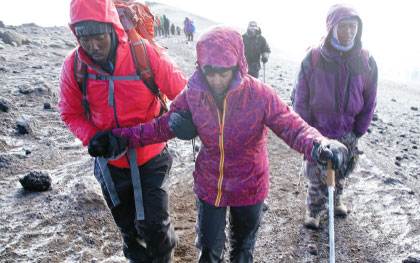
Hitting the wall: Dr. McCain helps Mona complete the last few feet.
Anyone who lives with limb loss or limb difference can always find a reason that something can’t be done. The Cloud Walkers are no exception. One climber in particular, Torres, had a better excuse than most if he wanted to back out of the climb. It has been a decade since he lost his right leg at the hip. At the time of the climb, he hadn’t used a prosthesis for several years. He made the entire climb on crutches, and there can be no better reason not to climb a mountain than the fact that you have one leg and get around on crutches. Then too, there’s no better reason to climb Kilimanjaro on crutches than the fact that it’s there.
Torres, like all The Cloud Walkers, was selected based on Patel’s assessment of their willingness and ability to complete the necessary training, as well as their ability to function under stress as a supportive member of a cohesive team. Group dynamics were critical to the expedition. Success depended on each climber’s commitment to team success, and Patel demanded full participation of all team members in the months leading up to the climb, dismissing one would-be climber for failure to make a required training hike. Says Patel, “You can ask anyone on the team what a strict drill sergeant I can be.”
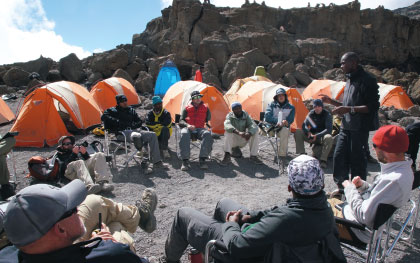
Summit debriefing.
When the challenge is to take a team of people with physical limitations up a mountain that has claimed the life of many an able-bodied climber, strictness is just common sense, even more so at a cost of $6,000 per climber. Patel took it seriously and her attitude carried over to the group.
In mountain climbing, as in so many endeavors, excellence is the result of working hard while no one is watching. The Cloud Walkers traversed 42 miles up and down in eight days, battling blisters, bruises and tears, fighting the elements, sometimes struggling for breath. Pfaff bled into his boots through torn skin at the site of former grafts. Socket fit became an issue for most team members, with limbs shrinking from the daily exertion.
This wasn’t a matter of standing in front of a summit sign for a selfie. It was an ordeal that succeeded because of training and serious preparation. That preparation paid off. Medical and prosthetic specialists plus a team of experienced porters provided the necessary professional support. Heart and determination provided most everything else.
A week-and-a-half after boarding a flight for a 30-hour trip, followed by eight days of climbing, the team returned home with each team member changed by the experience. Patel, a licensed clinical social worker, is modest about her own role, saying, “I learned a lot about myself as a teammate and as a leader. … This experience has given me an extra tool to use in working with patients facing life after limb loss.” She reserves her strongest praise for the team as a whole and stresses that the biggest lessons of the climb were those shared by everyone.
“If you don’t try,” she says, “you’ll never know what you can do,” adding, “Your goals don’t have to be as grand as climbing Mount Kilimanjaro. Set attainable goals, whatever they may be, and build on each accomplishment.”
The news is filled each day with stories of remarkable achievements by people with diverse physical challenges. With the Paralympics in Rio de Janeiro slated for September of this year, challenged athletes the world over are coming into peak form and in competition after competition barriers crumble, records fall and heroes emerge. Elite athletes prove that difference of ability does not equal disability.
The Cloud Walkers, however, are not elite athletes. None of them are veteran mountaineers. None have shoe sponsors or endorsement deals. They all have families and responsibilities and commitments that come before their own personal challenges. Fitting a trek up Africa’s tallest peak into their lives came with no reward at all, except for the intrinsic reward of exceeding one’s own expectations, a reward worth more than gold.
Describing his own experience after losing his right leg, Robinson recounted, “I was sincerely freaked out. … Am I really going to be able to go back to work and manage a tire store?” He did, in fact, go back to work managing a tire store and his days are busy all day, every day. That achievement, getting back to work despite being freaked out, is at least as impressive as climbing a mountain. But climbing the mountain signaled to Robinson and all other climbers that they truly have overcome their disadvantage. There is a strong message in each climber’s story about human adaptability.
There is another important message to take from The Cloud Walkers’ experience, which is their living testimony to the importance of technology for everyone living with limb difference. Yes, the indomitable wills on Kilimanjaro last December were important. However, willpower alone won’t get a one-legged climber up a hill. But willpower, matched with the right equipment – that’s practically limitless.
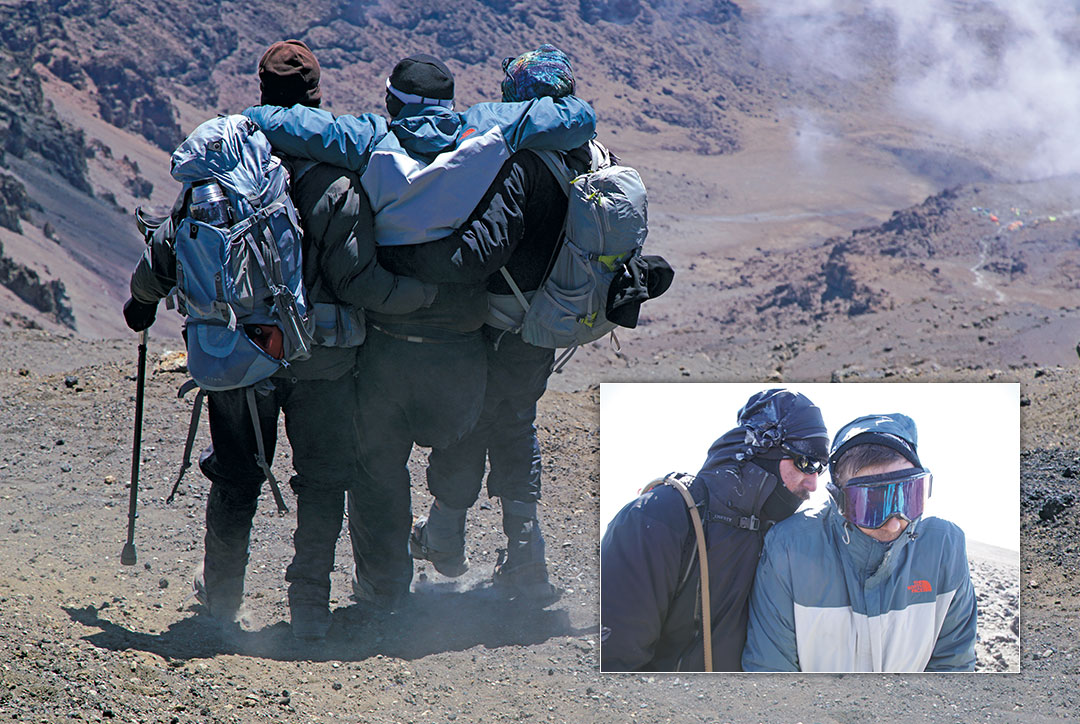
Cory being carried down by porters after summitting.
Inset: Medic Rick motivating Cory to keep going during their summit ascent.
In the year leading up to the climb, Patel worked with sponsors, donors, travel planners and many others. None were more important than the prosthetic manufacturers, whose products took the place of nature’s feet, hands, arms and legs. Without high-tech equipment, The Cloud Walkers’ story might have had a very different ending.
There were prosthetics of all varieties, upper and lower, along with climbing poles with specialized grips, even high-performance, custom-designed crutches on the mountain.
Patel says, “Our price [for the climb] included one personal porter per climber but we paid for additional porters to carry extra gear. We had a duffle bag … with just prosthetic supplies. We also took extra prosthetic limbs.”
The advantages of technology can’t be over-emphasized. The Cloud Walkers are proof of what can be done and they’re also evidence of what still needs to be done. Not everyone living with limb difference has access to organizations like the San Antonio Amputee Foundation. Not all amputees have the advocacy and support of champions like Mona Patel. There are still far too many people sentenced to limited mobility, lack of function and modest aspirations, all because the technology that could change their lives remains out of reach.
As The Cloud Walkers ascended Kilimanjaro, hundreds of thousands of amputees in sub-Saharan Africa went through their daily lives without modern prosthetics. In a half-dozen countries with war-torn pasts, where hacking off the limbs of men, women and children has become a political weapon in this century, the advances of Western technology are still largely unknown. In the advanced world, as well, the state-of-the-art trickles down slowly to the masses. What technology can do is one thing. Who can get the best technology is something else entirely.
While there is no more uplifting story than the account of The Cloud Walkers and their triumph on Kilimanjaro, that same story should also motivate continued hard work for all members of the limb loss community. Work remains to ensure that The Cloud Walkers story is not an anomaly. Policy advances in many states have brought prosthetic coverage within reach of most patients in the U.S., but there are still people with no prosthetic benefits and no access to basic technology, let alone the high-tech gear that makes the news.
Not all amputees will ever climb a mountain. But metaphorically, everyone living with limb loss knows how steep the climb can be. The challenge for future Cloud Walkers and for all of us is to lower the bar separating will from technology. The obstacles will always be there, and perhaps the best reason to challenge them will always be because we can.
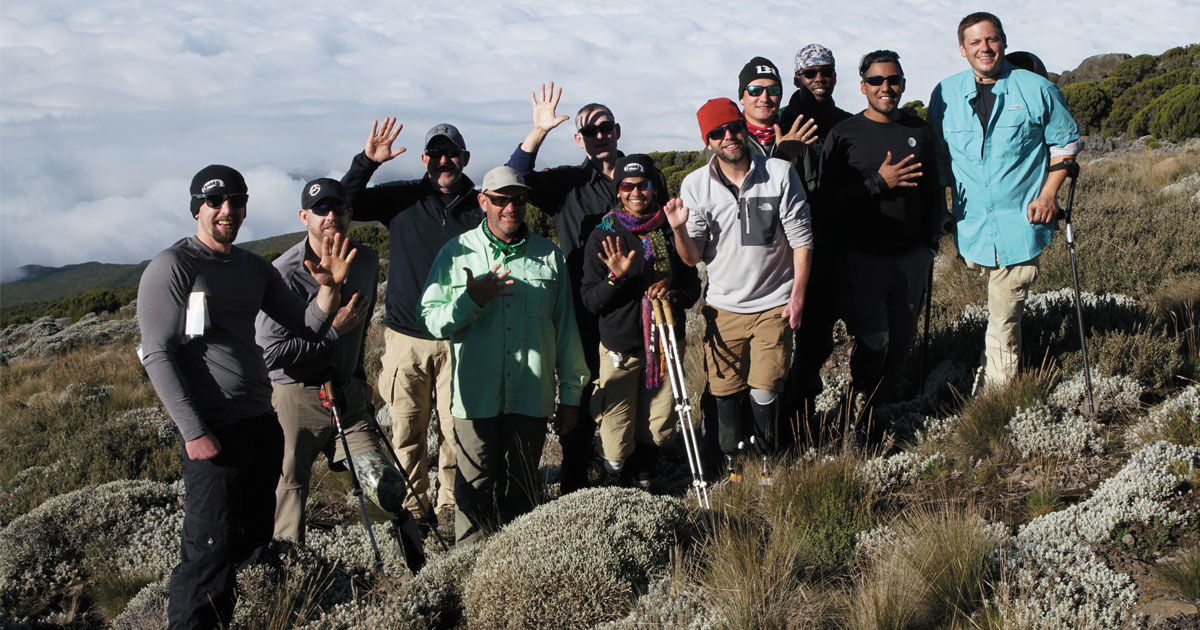
Above the clouds: Left to right (back row): Justin (team prosthetist), George, Rick (team medic), Greg (team physical therapist), Scott, Karwin , Johnny, and Cory. Left to right (front row): Kevin, Mona, and Ian.



